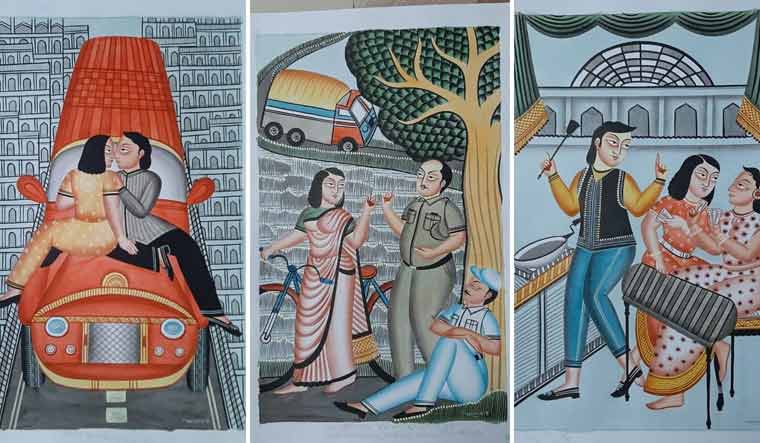In the painting 'Gari Ashche', a bored policeman inquires from a woman passing by if she has seen any car coming in his direction; he hasn't collected any bribe for days because of the lockdown.
In 'Hot Hero', rendered in the style of a traditional Kalighat painting, home quarantine has made the 'Nayak', a kitchen king, while his 'Nayikas' are lounging around playing cards.
In 'Sanitizer Vaccine', a babu is dancing with a wine bottle, amazed that his broom-wielding wife does not see the goodness of alcohol which fights COVID-19, while in 'Mukhor Dhari', the painter compares the face mask with the net that farmers use to tie the mouth of the oxen to prevent them from eating crops.
This is the funny thing about adversity. Continued confinement and constriction, born out of a pandemic, can breed snark and levity in some. The school of art most easily amenable to register this grim sense of humour is the 19th century Kalighat paintings from Bengal, when a rise of 'Babu Culture' saw patuas (painters’ community) lampoon the manners of the upper class Bengali gentleman. The rural folk paintings reinvented themselves from religious souvenirs sold around the Kali temple area in Kolkata's Kalighat to satirical portraits of urban social milieus and their aspirational characters. The rural artisans or patuas, who observed the foibles and idiosyncrasies of the cosmopolitan set, came from different districts of West Bengal to make a living.
In Anwar Chitrakar's solo exhibition of lockdown-inspired paintings titled 'Tales of our Times', now showing online at Emamiart.com (Emami Art website), the artist has tried to capture the non-dramatic and mildly laughable events of our COVID-stilted lives. Born in 1980 to a traditional patua family at Naya Village, West Midnapore, Anwar received his training in Bengal folk paintings from his father Amar Chitrakar. Working within the stylistic boundaries of Kalighat painting, Anwar, however, does not repeat the past, but uses the visual potential of the conventional art forms to capture the transitory sights and emotions of the contemporary. So the 19th century oiled babu holding the pleat of his dhuti and lazily smoking a hookah is replaced with mask-wearing residents of quiet neighbourhoods skirting around empty streets, roving cops and migratory birds.
In the pata paintings showcased by Anwar in ‘Tales of our Times’, a lot of detailing has gone into the iconic figuration, flowing lines, and tonal volumes. Anwar plays the painter as a flamboyant storyteller and a humorist. "Art is really the way we choose to want to live. Anwar, though he belongs to the patua legacy, is very contemporary in the delivery of his art. He is absolutely today. These were created now," says Richa Agarwal, CEO of Emami Art. "The exhibition is not Bengal-relevant, but time-relevant. As soon as the work went online, a couple of works were picked up by collectors from Maharashtra," says Agarwal, pointing out how online exhibitions on regional art have found new buyers.
'Tales of our Times' is on view till July 31.



